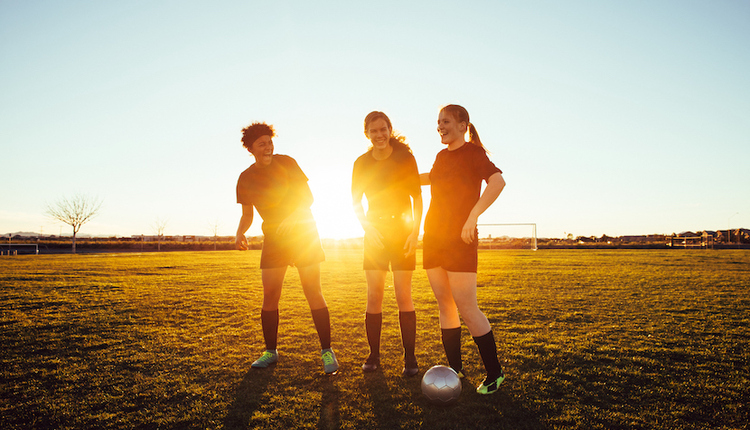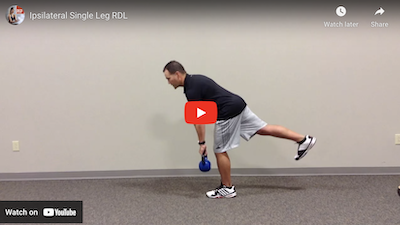
Before 1972, approximately 290,000 female athletes played organized sports. After Title IX was implemented, we have seen incredible growth in female participation in organized sports. Today, over 3.2 million female athletes are playing high school sports. Of those, less than 10% are required to do any form of strength training at the high school level.
Contrast that with males, where the average is 50%. That is a MAJOR problem. It makes sense then that female athletes between the ages of 14-18 are 4-8 times more likely to tear their ACLs than boys of the same age.
Eight years ago, I received a life-changing call from a physical therapist. He had a female athlete who was 4.5 months post ACL reconstruction and looking to start a return-to-sport program. This 14-year-old girl was a goalkeeper with one purpose — play Division 1 soccer. Oh, and she was 5’5”. Not exactly a blue-chip prospect, but we began the work.
As we built and adapted the program, I found multiple things. First, she listened and took feedback well. Second, her progress was consistent over time. Third, she achieved serious results.
As her success on the training floor translated to the field, we received more female athletes looking to recover from ACL injuries and athletes looking to prevent injury and maximize performance. This success allowed us to build a niche for training female athletes. Training female athletes doesn’t require significant differences in training modalities. Still, it does mean mastering some fundamental concepts that will help females reduce the risk of getting hurt, allow them to play with unshakeable confidence and cultivate a lifelong habit of training.
Make Single Leg Training a Focus
With an increased risk of ACL tears, single leg training should be an integral part of working with female athletes. The benefits are significant regarding injury reduction, stability, strength and improved performance on the field or court.
In sports, athletes are constantly expressing or absorbing force on one leg. Our job is to make sure they can handle those forces. Females have some anatomical disadvantages that place more significant stresses on the knee such as a wider Q angle, smaller ACLs and intercondylar notches than males. To combine those differences with the lack of overall strength training requirements, it presents challenges we as coaches must overcome.
Our primary goal is to create stability in the knee. We do this through developing awareness and strength in the foot and ankle, as well as the hip and glute, to prevent the valgus collapse of the knees. We need the knee to maintain a position centered over the middle of the foot.
We start with 3 movements to prioritize stability, then progress to build strength and power. These movements are specifically designed to allow for progression or regression. We are looking for the athlete to earn the right to move forward through the mastery of each movement.
1. Hurdle Hops: Linear & Medial/Lateral
- Hops tell the story of an athlete's true ability to absorb force. In this context, a hop is taking off on one leg and landing on the same leg. We begin this process by getting the athlete to stick the landing. This can be done over a small hurdle, or you can start with a depth drop off a shallow box. We are assessing whether an athlete can land and maintain the knee over the middle of the foot. We need the athlete to master this position before progressing to a dynamic hop.
- Once an athlete has earned the right to move on, we move to a plyometric phase, with a quick mini bounce, or double tap in between the hurdles. Following that, we will progress them to a continuous hurdle hop, focusing on getting down and up off the ground as quickly as possible, without sacrificing power output.
- The athlete can complete 3-5 hurdles per leg per set. At the end of each set, they should focus on sticking the landing so they are able to absorb force after a dynamic output.
- Performing these hops in a linear and medial/lateral way will show their ability to control their body in different planes, which will provide us with clues as to how to better train them.
2. Rear Foot Elevated Split Squats
- Building strength unilaterally is a major part of injury reduction and performance training. The challenge is that most athletes will still struggle with stability during a strength exercise such as a Single Leg Squat or a Skater Squat. This struggle will help build stability but will reduce the speed with which they will build strength. Using a movement like the Rear Foot Elevated Split Squat is great to build strength at a faster pace since the back leg is supported on a pad. That support will allow for greater progressions in weight, while also providing options for eccentric and isometric for different challenges.
- Again, the athlete must earn their way to each progression. Start with bodyweight, focusing on eccentric control. From there, progress to weighting the movement appropriately. Holding weights in their hands, instead of a barbell or safety squat bar on their back, provides for the safest version of this movement that allows them to be confident that if they fail a rep, they won’t get hurt.
- This will allow for total development of the lower leg, especially recruiting the glute as well as the quad.
3. Single Leg RDLs
- Speaking of recruiting the glute, the Single Leg RDL is a movement that is important to master. This movement should start with bodyweight and preferably be done barefoot, to make sure that the foot is connected to the ground and not overpronated.
- Many athletes struggle with this movement because they lack the ability to hinge well at the hip. This movement is so important that we include it in the warmup every day to help athletes get more reps and master it.
- Once an athlete has earned the right to progress, then we add weight. You can load this ipsilaterally, contralaterally or with 2 KBs. We are looking to maintain a rigid spine and stability in the hip, knee and ankle throughout the progressions.
Progressively challenging athletes with these three movements will make a significant difference in reducing injury risk while also building athletes that are stronger and more powerful. Single leg training for female athletes will translate to the field or court in a significant way.
Differentiate Yourself
Building a program focusing on female athletes is the simplest and most effective way to make an impact and earn more income in your training business. Most studios offering high school athletes sports performance training are seeking ways to differentiate themselves.
Here are a few more things to keep in mind when training female athletes:
- Create an environment that is inviting and not intimidating. Most females are still not training anywhere. If we want more female training, we must provide a welcoming facility. Your facility should be safe. It should be clean, well-lit (inside and outside) and have a respectable dress code. Your coaches/team should aim to welcome everyone by name within the first 5 seconds of them walking into your facility. You get one opportunity to make a first impression, and if yours doesn’t immediately make the athlete feel safe and comfortable, you will have an uphill battle.
- Get them to LOVE IT! In 2017, I heard the simplest and best definition of long-term athletic development from Eric Cressey, owner of Cressey Sports Performance. “Get them to LOVE IT!” It was spot on. As trainers, we tell our clients to “Fall in love with the process.” We know this is true, but with athletes, we often focus too much on training and too little on cultivating fun to keep them consistent. For most of us, somewhere in our journey, we had a coach who pushed us hard but ALSO made us fall in love with “the process.” Get to know your athletes and have some fun in your training. If they enjoy it, they will keep coming back. If they keep coming back, we have a greater opportunity to achieve results that last.
- Attend Their Sporting Events Giving them your time is the best way to show someone you care. It means the world to them that you would take the time out of your schedule to watch them play the sport(s) they love. It also shows the parents that you are interested in their athlete's success, not just the money they pay you. You will see how your program is helping them improve as an athlete. What must you change, add or subtract from their training? This offers tremendous insight into making improvements in your program. It is also the EASIEST marketing strategy EVER! After the game, take a picture of you and your athlete, post it on social media and tag them and their parents!
As a fitness business owner, building a program specifically for female athletes is a win-win scenario if you want to make an impact and increase your income.
Justin Kegley, CSCS, CFSC, is a Performance Coach, Speaker and Author. He is the Founder and Co-Owner of Movement Fitness, a Personal Training and Sports Performance Facility in Rockford, IL. Justin is an energetic coach, dedicated to helping athletes and adults reach peak performance through physical training and his Be Great Today Mindset. Over the last decade, Justin has specialized in coaching female athletes to maximize performance, reduce ACL injuries, and build unshakeable confidence. He is a follower of Jesus, married to Theresa, and they have 3 boys: Riley, Cooper, and Colton.











